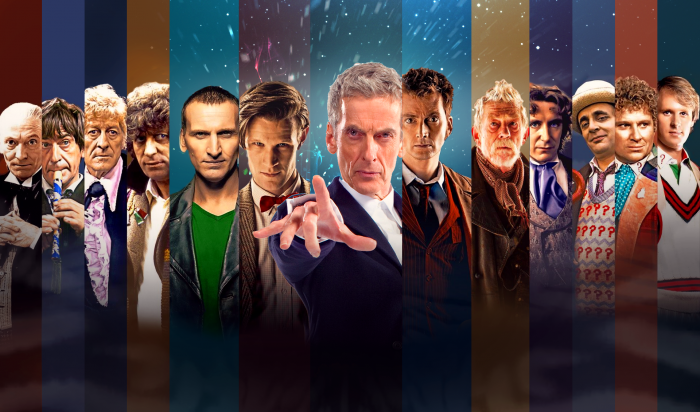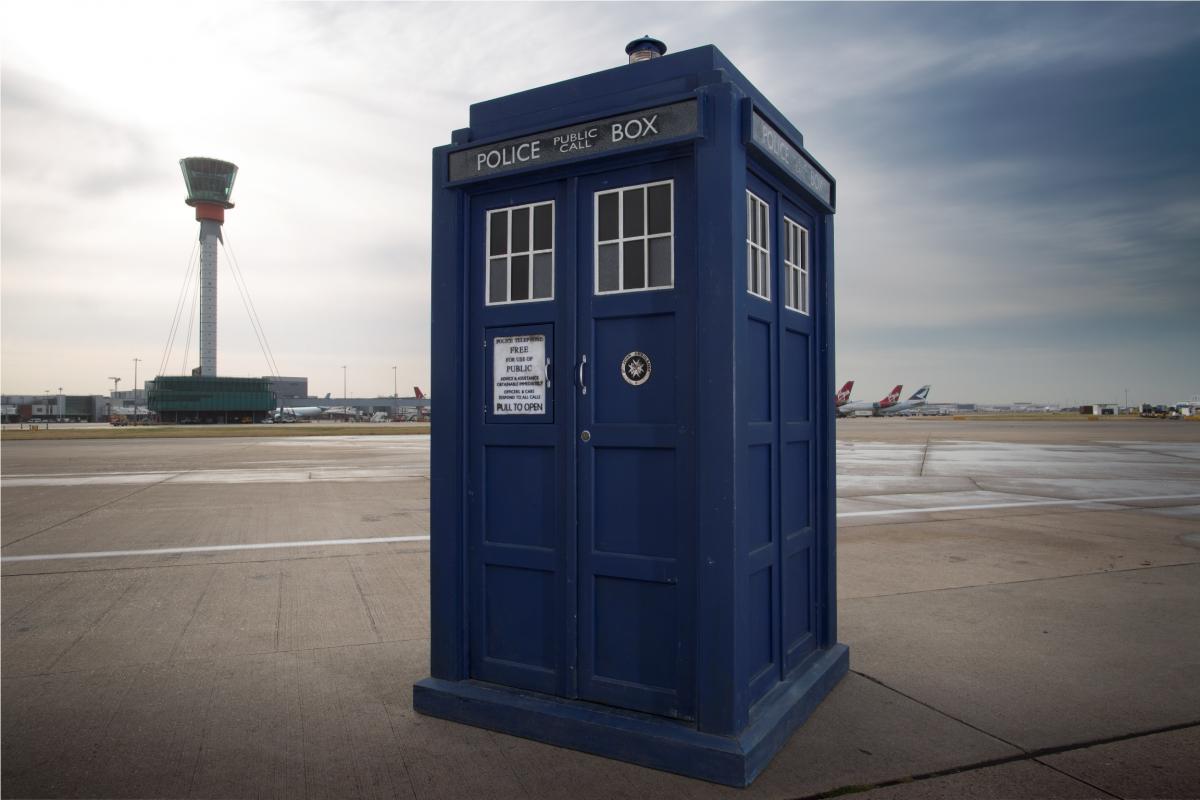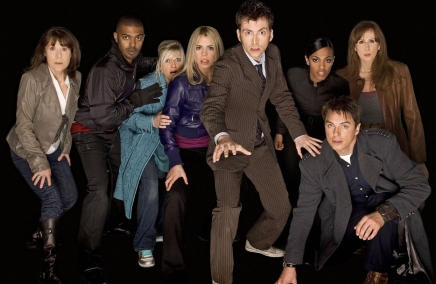A Beginner's Guide to Doctor Who - Part 1
FTC Statement: Reviewers are frequently provided by the publisher/production company with a copy of the material being reviewed.The opinions published are solely those of the respective reviewers and may not reflect the opinions of CriticalBlast.com or its management.
As an Amazon Associate, we earn from qualifying purchases. (This is a legal requirement, as apparently some sites advertise for Amazon for free. Yes, that's sarcasm.)

Last season, I managed to do reviews for each episode of Doctor Who within a day or two of them airing, and I definitely plan on doing that again this year when Doctor Who returns on September 19. So, what I decided to do is create this little primer on Doctor Who for anyone new to the series who might want to check it out.
Actually, Doctor Who superfan Craig Ferguson beat me to this years ago, so I guess I should start with stealing from him:
In retrospect, I realize that might not have been as helpful as I thought. Let me try it another way...
Doctor....who?
The first thing you need to know is that there is no character in the show that is named Doctor Who. The main character is just called "The Doctor". Doctor Who is just the name of the show, and often used as an inside joke during the episodes. We don’t know The Doctor’s real name, but he has been travelling as The Doctor since well before the show started. The Doctor is from the planet Gallifrey, a planet that at one time was home to a powerful and long lived race of beings called Time Lords. Kind of like Marvel’s Watchers, the Time Lords typically try not to interfere too much in the lives of other beings. They are able to travel through time and space in their TARDIS (time and relative dimension in space) ships.
 A TARDIS is designed to me much larger on the inside than it appears to be. A working TARDIS also features the ability to blend in with its surroundings. The chameleon circuit on The Doctor’s TARDIS is busted, so for the run of the show, the TARDIS has been stuck as a blue Police Box from 1960’s London. This is one of the most iconic images in science-fiction.
A TARDIS is designed to me much larger on the inside than it appears to be. A working TARDIS also features the ability to blend in with its surroundings. The chameleon circuit on The Doctor’s TARDIS is busted, so for the run of the show, the TARDIS has been stuck as a blue Police Box from 1960’s London. This is one of the most iconic images in science-fiction.
When The Doctor was a young Time Lord, he decided to steal a TARDIS and get more “involved” with the outside universe. For the past 2000 years or so, he has been wandering throughout time and space, seeing the sights, and fighting evil where he encounters it, typically using his wits to save the day more than any real fighting prowess. He even spent some time banished on Earth by the Time Lords.
The Doctor’s personality tends to fluctuate some throughout his various incarnations. For the most part, he’s a cosmic vagabond. Brilliant and curious, determined to help people when he can, but his primary concern is just traveling. When asked for his Name, Rank, and Intention, he once replied “The Doctor, Doctor, Fun” which is the perfect description. For the most part, he tries to keep things light, but he’s capable of some dark actions when he needs to be.
Where did Doctor Who (the show) come from?
Way back in 1963, the BBC was looking to create a new education and entertainment program for the entire family that would feature time travel. Stories set in the past were intended to teach about history. Stories set in the future were intended to show off science and the possibilities of the future.
Pretty much from the beginning the show became a huge hit, and the star William Hartnell became a beloved figure. But Hartnell’s health started to fail in the third season. In order to ensure the show would keep going, they came up with the idea of regeneration. When a Time Lord is approaching his death, their body undergoes a metamorphosis into a new form, with a new personality and look. This would allow the show to extend its life by being able to replace the main actor in a logical, story-driven way whenever it was necessary. William Hartnell was replaced by Patrick Troughton. In the shows initial run from 1963 to 1989, the Doctor was played by seven different Doctors. We will be talking more about them in future installments of this column.
For the entire original run of Doctor Who, the stories were done in serial format, ranging between 2-12 episodes long. Some of these serials do feel a little padded. BBC’s funding is basically “by the length of the show” not the content. This results in many of the classic episodes looking cheap, or them padding the serials to be able to get a bigger budget to be used in some of their more demanding episodes.
By 1989, the show had basically grown kind of stale in many people’s mind, so it went off the air. BBC did try to revive it in a co-production with Fox in 1996 with a movie starring Paul McGann. Sadly, Paul McGann was just about the only good thing in that movie, so DOCTOR WHO seemed pretty destined to remain in the nostalgia bins.
Finally on March 26, 2005, DOCTOR WHO was brought back one more time. This time, it was helmed by Russell T. Davies, who was best known at the time for QUEER AS FOLK. The new DOCTOR WHO stood on its own, but made plenty of references to the whole show, making it ideal for old and new fans. They were also able to do much better special effects than the older DOCTOR WHO…even though they are still stuck under BBC’s archaic funding structure. Honestly, I have no idea how they manage to pull off the effects they do these days. They are close to cinematic.
For the relaunch, they went a lot younger with the Doctor, having Christopher Eccleston take over the iconic role. The new DOCTOR WHO presented us with a much more somber Doctor. We find out that the Doctor was forced to kill his entire race in order to help end the Last Great Time War with the Daleks (more on them later in the column).
Chris Eccleston only stayed in the role for a year, turning it over to David Tennant, who is probably the most popular version of the Doctor. Russell T. Davies and David Tennant both left the show in 2010, with Matt Smith taking over as The Doctor and Steven Moffat taking over as the showrunner. This continued the trend of the Doctors getting younger and younger.
Last year, Matt Smith was replaced by the current Doctor...Peter Capaldi. Capaldi is a little older than the modern Doctors (in fact, he's older NOW than Paul McGann who played the Doctor almost 30 years ago), but he comes with major acting chops. Capaldi also happens to be a lifelong Doctor Who fan, and it shows in any interview or fan interaction he has. Capaldi did a terrific job in his first season as The Doctor and I'm really hoping he stays in the role for a long time.
It should also be pointed out the John Hurt played a version of The Doctor for the 50th Anniversary special that came out in 2013. In the special, we find out that between the Eighth and Ninth incarnations of The Doctor there was a version of The Doctor that fought in the Time War. Since the Doctor is mostly a pacifist, the other incarnations have seemed to try and forget he even existed. This version is typically referred to as The War Doctor, and he was the one responsible for blowing up his own home planet to stop the Time Lords and Daleks alike who were both doing horrible things to time and space. In the 50th Anniversary, The War Doctor was given a chance at redemption (with the help of the Tenth and Eleventh incarnations of the Doctor), and they are able to save Gallifrey and the Time Lords by freezing Gallifrey in stasis outside of the time stream. The Doctor was supposed to go looking for his people, but the show seems to have lost track of that some.
 The Doctor's Companions
The Doctor's Companions
When discussing The Doctor, it's important to mention his travelling companions. Since The Doctor is so alien, in order to help the audience relate more to him, he has pretty much always travelled with at least one (often more) companions. More often than not, his companions are young, attractive females, and even though he travels all over time and space, they are from modern day England. In Classic Who, the characters had more of a father-child relationship, but in modern Who, most of the Doctor's modern companions have had at least some kind of flirtatious relationship with the Doctor.
This turned around last season, with the Twelfth Doctor making it real clear to Clara (his current companion) that "I am not your boyfried." For this long time fan, I think this is a huge step in the right direction. As much as I've like Rose Tyler, Martha Jones, and Amy Pond, it never quite felt like Doctor Who when they were around.
The only regular modern companion that avoided that trap was Donna Noble, played by Catherine Tate. Donna was strong willed and had no interest in the Doctor except as a way of escaping the drudgery of her life. She became friends with the Doctor, not looking for a boyfriend. Which made her ending more tragic than just about anything else in Doctor Who. We've had characters die or leave the Doctor to get married or just because the travelling life has worn them down. After taking on some aspects of the Time Lord to help stop a massive Dalek invasion, Donna's brain was facing total meltdown. The Doctor was forced to make her forget about her adventures, and lose all the development she made over the course of the season. Any further contact with The Doctor would most likely kill her.
Daleks and other bad things
In his travels, the Doctor has encountered a lot of evil beings. His most persistent enemies are the Daleks. The Daleks first appeared in Doctor Who's second serial way back in 1963. They are ruthless killing machines, obsessed with Dalek purity. Uhm...they also have plungers for one arm and what looks like an egg whisk for the other arm. And one buggy eye on the eye of a stalk sticking out of the middle of its head. They also have high pitched squealing voices:
Don't ask me how this all comes together to create the most evil race in the universe, but somehow it works. Credit that with the extremely good writing Doctor Who has had over the 51 years it's been on the air. Because they sure don't look scary on their own.
The Daleks were supposed to have been wiped out in the Time War, but over time they have managed to weasel their way back into the Doctor’s life.
While Doctor Who has had a lot of recurring adversaries over the years, including the Cybermen and the Sontarans. BUT, my favorite Doctor Who villain is The Master, a rival Time Lord who has been a huge part of Doctor Who since the early 70’s. The Master is a brilliant strategist who often plays the long game in his efforts to rule the universe and to destroy The Doctor. He’s basically The Doctor’s Moriarity. I know that is a far from original sentiment, but it fits.
Like The Doctor, there have been quite a few actors who have played the role. The original Master was Roger Delgado, who happened to be close friends with Jon Pertwee who was The Doctor at the time. Unfortunately, Delgado died in a car accident. Anthony Ainley would take over the role a few years later and played it for 9 years. Ainley was a little more over the top than Delgado, but I suspect a lot of that was the scripts he was given.
The Master finally returned to modern Who in the third season, played by John Simm. John Simm went even more over the top than Ainley at times, but he was still great in the role.
Last season, they introduced a twist to the character with The Master returning as “The Mistress” played by Michelle Gomez.
Missy is supposed to have a much bigger role in the upcoming season, and I look forward to that.
The Doctor and I
We’re pretty much wrapping up, but I wanted to talk about my connection to Doctor Who. I have always loved British TV and movies, and my friends have always told me that I needed to check out Doctor Who, and I kept putting it off. All I know about the show was the Doctor had a ridiculous long scarf and for some reason, the show was connected to a weird blue phone booth, like he was Bill and Ted. I remember when the show came back in 2005 and everyone was making a big deal about it, but I still ignored it.
Just after the third season aired, I was sitting in my sister’s house. She had an issue of Toyfare sitting on the table, and I started flipping through it. The issue had a extensive article about Doctor Who, and I ended up reading it and was really impressed by everything they had to say about the show.
One thing that stuck with me about the article was they teased a mysterious line from the third season with The Face of Boe telling the Doctor “You Are Not Alone” (which led to the return of The Master). I ended up getting Netflix just so I could catch up on the modern series. No exaggeration, my wife and I ended up watching the first three seasons faster than they could send us new DVD’s (this was before Netflix was doing a lot of streaming video). The first episode of Doctor Who I got to watch “live” was VOYAGE OF THE DAMNED, although this was before the show was aired at the same time in Britain and America, so I had to bootleg it.
So long story short, I kind of hope that someone will stumble across the article, just like I stumbled across that Toyfare article and give Doctor Who a shot. You will not be disappointed!


